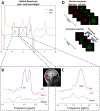Relating excitatory and inhibitory neurochemicals to visual perception: A magnetic resonance study of occipital cortex between migraine events
- PMID: 31291247
- PMCID: PMC6619596
- DOI: 10.1371/journal.pone.0208666
Relating excitatory and inhibitory neurochemicals to visual perception: A magnetic resonance study of occipital cortex between migraine events
Abstract
Certain perceptual measures have been proposed as indirect assays of brain neurochemical status in people with migraine. One such measure is binocular rivalry, however, previous studies have not measured rivalry characteristics and brain neurochemistry together in people with migraine. This study compared spectroscopy-measured levels of GABA and Glx (glutamine and glutamate complex) in visual cortex between 16 people with migraine and 16 non-headache controls, and assessed whether the concentration of these neurochemicals explains, at least partially, inter-individual variability in binocular rivalry perceptual measures. Mean Glx level was significantly reduced in migraineurs relative to controls, whereas mean occipital GABA levels were similar between groups. Neither GABA levels, nor Glx levels correlated with rivalry percept duration. Our results thus suggest that the previously suggested relationship between rivalry percept duration and GABAergic inhibitory neurotransmitter concentration in visual cortex is not strong enough to enable rivalry percept duration to be reliably assumed to be a surrogate for GABA concentration, at least in the context of healthy individuals and those that experience migraine.
Conflict of interest statement
I have read the journal’s policy and the authors of this manuscript have the following competing interests: Yu Man Chan reports no disclosures. Kabilan Pitchaimuthu received Melbourne International Research Scholarship and Melbourne International Fee Remission Scholarship from the University of Melbourne. Qi-Zhu Wu is an employee of Shenzhen Sinorad Medical Electronics Inc., Shenzhen, China. Olivia Carter is funded by Australian Research Council Future Fellowship grant #FT140100807 Gary Egan receives funding support from the Australian Research Council Centre of Excellence in Integrative Brain Function (CE140100007) David R. Badcock is funded by the Australian NHMRC (APP1081874) and Australian Research Council (DP160104211). Allison M McKendrick receives research support from Heidelberg Engineering GmBH (Germany), CenterVue PdA (Italy), and Haag-Streit AG (Switzerland), and has research funding from the Australian Research Council and Australian National Health and Medical Research Council (APP1081874), and is an editorial board member of the following journals: Graefe’s Archive of Clinical & Experimental Ophthalmology, Clinical & Experimental Optometry; and Translational Vision Science Technology.
Figures




References
-
- Burch R, Rizzoli P, Loder E. The prevalence and impact of migraine and severe headache in the United States: figures and trends from government health studies. Headache: The Journal of Head and Face Pain. 2018;58(4):496–505. - PubMed
-
- Lipton RB, Stewart WF, Diamond S, Diamond ML, Reed M. Prevalence and burden of migraine in the United States: data from the American Migraine Study II. Headache: The Journal of Head and Face Pain. 2001;41(7):646–57. - PubMed
-
- Purdy RA. The role of the visual system in migraine: an update. Neurological Sciences. 2011;32(1):89–93. - PubMed
-
- Marzoli SB, Criscuoli A. The role of visual system in migraine. Neurological Sciences. 2017;38(1):99–102. - PubMed
Publication types
MeSH terms
Substances
LinkOut - more resources
Full Text Sources
Medical

